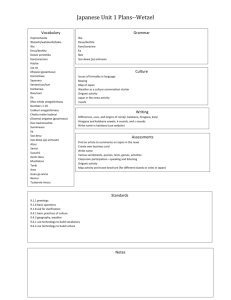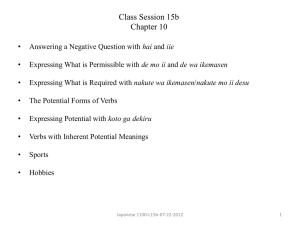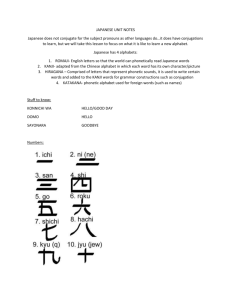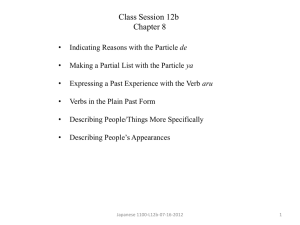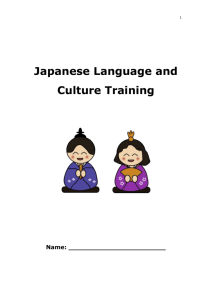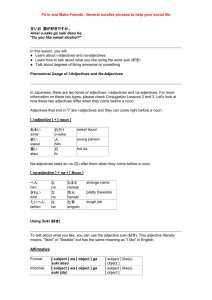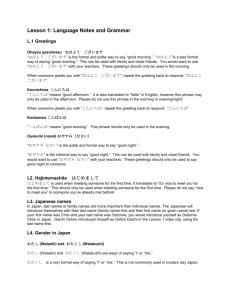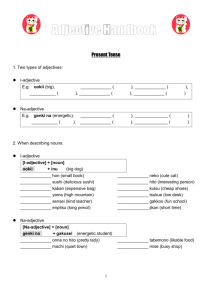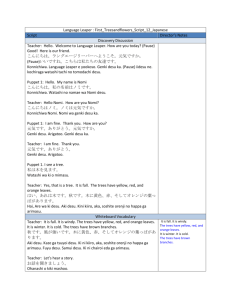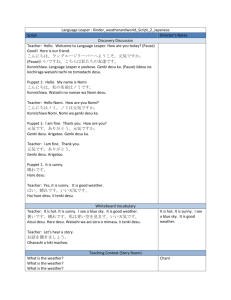Yr 6, T3 T4 2015, Mini Master Chef
advertisement
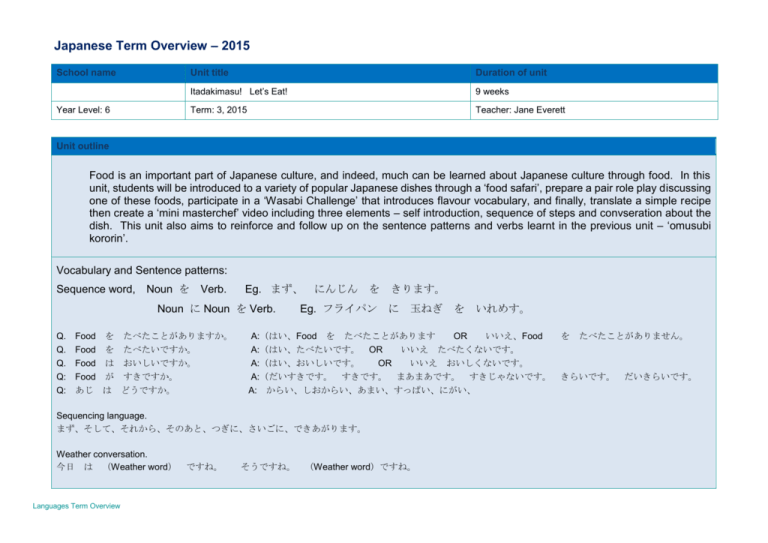
Japanese Term Overview – 2015 School name Year Level: 6 Unit title Duration of unit Itadakimasu! Let’s Eat! 9 weeks Term: 3, 2015 Teacher: Jane Everett Unit outline Food is an important part of Japanese culture, and indeed, much can be learned about Japanese culture through food. In this unit, students will be introduced to a variety of popular Japanese dishes through a ‘food safari’, prepare a pair role play discussing one of these foods, participate in a ‘Wasabi Challenge’ that introduces flavour vocabulary, and finally, translate a simple recipe then create a ‘mini masterchef’ video including three elements – self introduction, sequence of steps and convseration about the dish. This unit also aims to reinforce and follow up on the sentence patterns and verbs learnt in the previous unit – ‘omusubi kororin’. Vocabulary and Sentence patterns: Sequence word, Noun を Verb. Eg. まず、 Noun に Noun を Verb. にんじん を きります。 Eg. フライパン に を 玉ねぎ たべたことがあります を いれめす。 Q. Food を たべたことがありますか。 A:(はい、Food Q. Food を たべたいですか。 A:(はい、たべたいです。 Q. Food Q: Food は が おいしいですか。 すきですか。 A:(はい、おいしいです。 OR いいえ おいしくないです。 A:(だいすきです。 すきです。 まあまあです。 すきじゃないです。 Q: あじ は どうですか。 A: からい、しおからい、あまい、すっぱい、にがい、 OR いいえ Sequencing language. まず、そして、それから、そのあと、つぎに、さいごに、できあがります。 Weather conversation. 今日 は (Weather word) Languages Term Overview ですね。 そうですね。 (Weather word)ですね。 OR いいえ、Food を たべたことがありません。 たべたくないです。 きらいです。 だいきらいです。 Weather vocabulary. Languages Term Overview くもり、さむい、あつい、はれ、あめ、ゆき、ありあし Content descriptions to be taught Communicating Understanding Socialising Participate in everyday classroom activities and routines such as asking how to say or write something, asking for help or repetition, praising or complimenting one another, thanking, apologising and expressing preferences (nicchoku, wasabi game) Systems of Language Engage with authentic spoken language, recognising how words blend and understanding the relationship between sounds, words and meaning (noticing that certain combinations of two moras make one rhythm unit (foot), for example, the copula です and the verb suffix ます – recipe verbs.) Informing (Yr 4,5) Locate and process specific points of information in familiar types of written, spoken, multimodal and digital texts associated with people, places and objects (chocolate cake recipe) Creating Create and present or perform imaginative texts for a variety of purposes and audiences (mini masterchef film) Recognise some single and whole word katakana and develop the ability to use hiragana and kanji in a single text (katakana for food ingredients that are borrowed from English - understanding the use of basic Japanese punctuation marks such as まる(。) and てん(、), and katakana long vowel marks, for example, in a food words such as チョコレート) Translating Create bilingual texts and learning resources such as displays, websites, posters, picture books, games, word banks and menus (good copy of recipe for display) Recognise the systematic nature of Japanese grammatical rules and apply these to generate new language for a range of purposes (which particle to include for each verb and using conjunctions such as そして、それから to link ideas in recipe instructions.) Language Variation and Change Recognise that the Japanese language is both influenced by in turn influences other languages and cultures (borrowed words for food – make a list of borrowed words in katakana) Languages Term Overview General capabilities and cross-curriculum priorities Literacy (comparing Japanese and English words and usage, generic structure of folk tale) ICT competence (PPT skills, Japanese typing skills) Critical and creative thinking (adapting base rap to make it original) Personal and social competence (teamwork when working in groups to create new rap) Intercultural understanding (discussing values evident in Omusubi Kororin folk tale) Achievement standard – Year 5 and 6 By the end of Year 6, students use formulaic and modelled language in classroom interactions to carry out transactions and to share or convey information about daily routines, activities and events, using time expressions such as まい日、ときどき. They ask and respond to questions in familiar contexts using complete sentences and appropriate pronunciation, rhythm and intonation. They ask for clarification and assistance, negotiate turn-taking and follow instructions. They extend their answers by using conjunctions such as そして、それから. They show concern for and interest in others by making enquiries such as だいじょう ぶ?, and apologise and express thanks using appropriate gestures. They read and write all hiragana, including voiced sounds, long vowel sounds, double いぬ あめ consonants and blends, and high-frequency kanji, for example, 犬 , 小さい、 雨 . Students locate specific information and some supporting details in a range of spoken, written and multimodal texts on familiar topics. They express reactions to imaginative texts, such as by describing qualities of characters, for example, や さしい 人 です。. They create connected texts of a few sentences, such as descriptions, dialogues or skits. They structure sentences using particles, for うえ example, へ、で、を、が and prepositions, for example, の 上 に, and apply the rules of punctuation when writing. They describe and recount events and み experiences in time, for example, adjective です。noun です/でした。 and present/past/negative verb forms, for example, のみます、たべます、見ました、いき ません. They use counter classifiers in response to questions such as いくら です か。なんびき?なんこ?. Students translate familiar texts, recognising formulaic expressions and culturally specific textual features and language use. They comment on similarities and differences in ways of expressing values such as politeness, consideration and respect in Japanese compared to other languages and cultures. Students understand and use the hiragana chart to pronounce contracted and blended sounds and exceptions to phonetic rules, such as を、へ、は, and です. They understand and apply the rules and phonetic changes related to counter classifiers, such as さんぜんえん、いっこ、はっぴき. They apply their knowledge of stroke order to form characters. They give examples of ways in which languages both change over time and are influenced by other languages and cultures. They identify words from other languages used in Japanese, such as パソコン、メール、パスタ, and how the pronunciation, form and meaning of borrowed words can change when used in Japanese. Students identify behaviours and values associated with Japanese society and incorporate these into their own language use, such as ways of deflecting praise, for example, じょうず です ね。いいえ。 Assessment (Overview) Make judgments Describe the assessment Assessment date/period Pair role play. Language focus – weather, have you tried ___ before, do you want to try it? Term 3, Week 7 Wasabi game – Interviewer and Taster – speaking assessment Term 3, Week 10 Mini-Masterchef video – self introduction, recipe with sequencing language, conversation Term 4, Week 5 Languages Term Overview Learning Sequence Focus Week 4 Learning Activities including details of modifications to programme to cater for individual needs. (Support and Extension) L1 *Explain Gold Coast MLTAQ speech competition – hand out speeches. *Brainstorm foods that we know – record on Triptco’s Word Magnets *Play ‘I have ____, who has ___?’ with Japanese foods and descriptions. Play twice and show pics of food on ppt the second time. When showing last page of ppt, focus on names of each food and the hiragana labels. Any tricky words? L2 *Hand out safari sheets and put up last page of ppt on screen. Students practise writing the food words, and write an English description. They then tick the column for whether they have eaten the food or not, and whether they want to eat it or not. *Whole class discussion and practise of saying sentences using ‘tabetakoto ga arimasu / arimasen, tabetaidesu / tabetakunaidesu. Orientating Remembering & Understanding Week 5 L1 Hand out mini books and make together. Quizlet – Japanese food and translations L2 (Away – mapping) Week 6 Languages Term Overview Year 6 students in Canberra Resources laminated ‘I have’ cards PPT safari sheet dictionaries Quizlet activity Assessment Focus and Scope Learning Sequence Week 7 L1 *Introduce weather words with pictures *Explain pair task - random pairs -- students won't know who they're going to be with. *Hand out the criteria sheet and discuss - students to practise the sentence structures individually or with the person next to them. (I will be handing them a food card from our safari to use as the conversation base.) L2 *Practise as whole class, focussing on correct pronunciation. *Discuss extra language that could be included – how old are you? Where do you live? Me too! I can’t believe it! No! *Students in pairs to practise the conversation. – use the Japanese students to demonstrate and help. Week 8 Pair conversation criteria sheet Extra language cards for display L1 *Have students work on preparing for their pair conversation by practising in pairs. Call students in two at a time, to work through the speeches. *When finished, students work on the food and eating crossword puzzle. *If finished crossword early, students play hangman with the food words L2 Continue with pair role plays Week 9 Enhancing Applying & Analysing Languages Term Overview L1 Introduce flavours - amai, suppai, karai, shiokarai, nigai using actions. Amai - ammma too much sugar! Suppai - super sour, karai - hot like curry, shiokarai , nigai – bitter *Students write English meanings in mini book. *Practise wasabi o tabeyou with mini food cards in pairs *Practise in particular 'oishiidesuka' - hai oishiidesu / iie oishikunai desu food crossword puzzle mini food cards Rubric – Speaking Assessment Learning Sequence Aji wa dou desu ka. L2 Revise wasabi tabeyou game and demonstrate. Last practice of conversation Week 10 Languages Term Overview L1 Wasabi Tabeyou – use Triptico Flip to choose players 1. Player has mini food card or spinner in front of them. 2. Interviewer greets the player appropriately and asks name. Ohayou gozaimasu. Onamae wa nan desu ka? Player answers. Ohayo gozaimasu. Watashi no namae wa ________ desu. 3. Interviewer asks…Have you eaten ____ before? "_______ o tabeta koto ga arimasuka?" 4. Player answers. Either "hai ______ o tabeta koto ga arimasu." OR "iie tabeta koto ga arimasen." 5. Interviewer says 'here you go, please eat" "Douzo, tabete kudasai." Player says grace before meals "itadakimasu" , pretends to eat the food, then says 'grace after meals' 'gochisou sama deshta.' 7. Interviewer asks "do you like ____". ________ ga suki desu ka? 8. Player answers. Daisukidesu / sukidesu / maamaa desu / sukijanai desu / kiriai desu / daikirai desu. 9. Interviewer asks "is it delicious?" oishii desu ka? 10. Player answers. Either 'hai oishii desu. OR 'iie, oishiku nai desu.' 11. Interviewer asks "how does it taste?" Aji wa doudesuka? 12. Player answers - amai desu / suppai desu / karai desu / nigai desu / shio karai desu. 13. Interviewer and player say "thank you". Arigatou arigatou L2 Complete Wasabi tabeyou game Spinner Dark Chocolate Senbei Lemon Chips Wasabi Lolly observation of speaking ability - checklist Learning Sequence Term 4 Week 1 L1 *Introduce sequencing language with actions, write meanings in mini books, practise with partner. *Hand out task sheet with chocolate cake recipe in Japanese. Students to write the correct Japanese ingredients beside the words in English and roomaji. Chocolate cake recipe L2 Revise sequencing words Students write the sentences into their correct positions. Week 2 Synthesisin g L1 *Highlight the verbs from recipe. What is their position in each sentence? Write English for verbs in mini book. *Playing with sentences. Chop the onion. Etc. Students to look up the nouns in dictionary to write the sentence in Japanese. Emphasise verbs go at the end of the sentences. L2 Demonstrate how to simplify a recipe into simple English steps. Students begin to simplify their recipes. Evaluating & Designing Week 3 L1 *Show examples of previous years’ videos. *Go through criteria sheet carefully and explain sections. *Students begin to translate their sentences into simple Japanese sentences. L2 *continue translating Week 4 Languages Term Overview dictionaries L1 Complete translating *Students to rehearse Criteria sheet Minimasterchef rubric – focus on speaking and writing Learning Sequence L2 *rehearse - film during the week / over the weekend. Week 5 L1 *hand in films on usb L2 *Cooking activities – omusubi / yakisoba Week 6 L1 View ‘Master Chef’ fims hand written or digitally created recipes. L2 *Watch remaining Master Chef films.Students write up good copies of recipes for display. Week 7 L1 Hand Back Criteria Sheets discuss. L2 Begin recipe write-ups for display Week 8 L1 Continue writing up recipe for display L2 New Year Cards Languages Term Overview observe use of script
